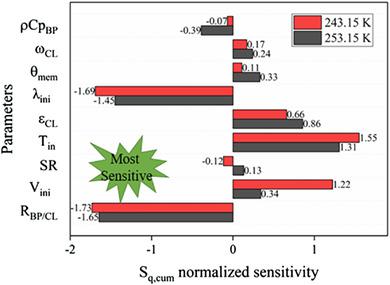当前位置:
X-MOL 学术
›
Int. J. Energy Res.
›
论文详情
Our official English website, www.x-mol.net, welcomes your feedback! (Note: you will need to create a separate account there.)
Parametric sensitivity analysis on the cold start process of a polymer electrolyte membrane fuel cell
International Journal of Energy Research ( IF 4.6 ) Pub Date : 2020-11-25 , DOI: 10.1002/er.6189 Huipeng Niu 1 , Changwei Ji 1 , Shuofeng Wang 1 , Du Wang 1 , Yongyi Bai 1 , Chen Liang 2
International Journal of Energy Research ( IF 4.6 ) Pub Date : 2020-11-25 , DOI: 10.1002/er.6189 Huipeng Niu 1 , Changwei Ji 1 , Shuofeng Wang 1 , Du Wang 1 , Yongyi Bai 1 , Chen Liang 2
Affiliation

|
Subzero start‐up of the polymer electrolyte membrane fuel cell (PEMFC) is one of the most challenging tasks to be solved before commercialization. During the subzero start‐up process, water generated in the oxygen reduction reaction at the cathode side of PEMFC is susceptible to freeze,which makes active sites covered by the ice and gases failed to reach the surface of the catalyst layer (CL), leading to a substantial decay and even ending up with a failure of the start‐up. Given that many factors affect the cold start process, the relative contribution of the essential factors on the cold start process is independently analyzed using first‐order finite‐difference sensitivity analysis from −20°C to −30°C. The effect of essential parameters on the cold start process is quantified. The investigated parameters include the ratio of bipolar plate (BP) thickness to that of the CL (RBP/CL), the starting voltage (Vini), stoichiometry ratios, inlet gas temperature (Tin), the porosity of the CL (εCL), initial membrane water content (λini), membrane thickness (θmem), the volume fraction of ionomer (ωCL) in CLs, and the heat capacity of the BP (ρcpBP). Results show that the cold start process is most sensitive to RBP/CL and λini. Significant improvement of cold start performance can be achieved by appropriately adjusting RBP/CL, λini, Tin, and εCL. Appropriately increasing the Vini also can be a method to improve cold start performance, especially for the cold start from −30°C. Besides, optimized ωCL in CLs, proper θmem, and lower ρcpBP can contribute to better performance, especially for the cold start from −20°C.
中文翻译:

聚合物电解质膜燃料电池冷启动过程的参数敏感性分析
聚合物电解质膜燃料电池(PEMFC)的低于零启动是在商业化之前要解决的最具挑战性的任务之一。在低于零的启动过程中,PEMFC阴极侧的氧还原反应中生成的水易于冻结,这使得被冰和气体覆盖的活性部位无法到达催化剂层(CL)的表面,导致严重衰减,甚至以启动失败而告终。考虑到影响冷启动过程的因素很多,使用-20°C至-30°C的一阶有限差分灵敏度分析独立分析了基本因素对冷启动过程的相对贡献。量化了基本参数对冷启动过程的影响。ř BP / CL),起始电压( V INI),化学计量比,入口气体温度( Ť中)时,CL(的孔隙率ε CL),初始膜的水含量( λ INI),膜厚度( θ MEM) ,离聚物(的体积分数ω CL在CLS)和BP(的热容量率ρc PBP)。结果表明,在冷启动过程是最敏感ř BP / CL和λ INI。的冷启动性能的改善显著可以通过适当地调节来实现ř BP / CL,λ INI,Ť在,和ε CL。适当增加V ini也是提高冷启动性能的一种方法,尤其是对于从-30°C开始的冷启动。此外,优化的ω CL中的CL,适当的θ MEM,并降低率ρc PBP可以向更好的性能,尤其是对于从-20冷启动℃。
更新日期:2020-11-25
中文翻译:

聚合物电解质膜燃料电池冷启动过程的参数敏感性分析
聚合物电解质膜燃料电池(PEMFC)的低于零启动是在商业化之前要解决的最具挑战性的任务之一。在低于零的启动过程中,PEMFC阴极侧的氧还原反应中生成的水易于冻结,这使得被冰和气体覆盖的活性部位无法到达催化剂层(CL)的表面,导致严重衰减,甚至以启动失败而告终。考虑到影响冷启动过程的因素很多,使用-20°C至-30°C的一阶有限差分灵敏度分析独立分析了基本因素对冷启动过程的相对贡献。量化了基本参数对冷启动过程的影响。ř BP / CL),起始电压( V INI),化学计量比,入口气体温度( Ť中)时,CL(的孔隙率ε CL),初始膜的水含量( λ INI),膜厚度( θ MEM) ,离聚物(的体积分数ω CL在CLS)和BP(的热容量率ρc PBP)。结果表明,在冷启动过程是最敏感ř BP / CL和λ INI。的冷启动性能的改善显著可以通过适当地调节来实现ř BP / CL,λ INI,Ť在,和ε CL。适当增加V ini也是提高冷启动性能的一种方法,尤其是对于从-30°C开始的冷启动。此外,优化的ω CL中的CL,适当的θ MEM,并降低率ρc PBP可以向更好的性能,尤其是对于从-20冷启动℃。



























 京公网安备 11010802027423号
京公网安备 11010802027423号